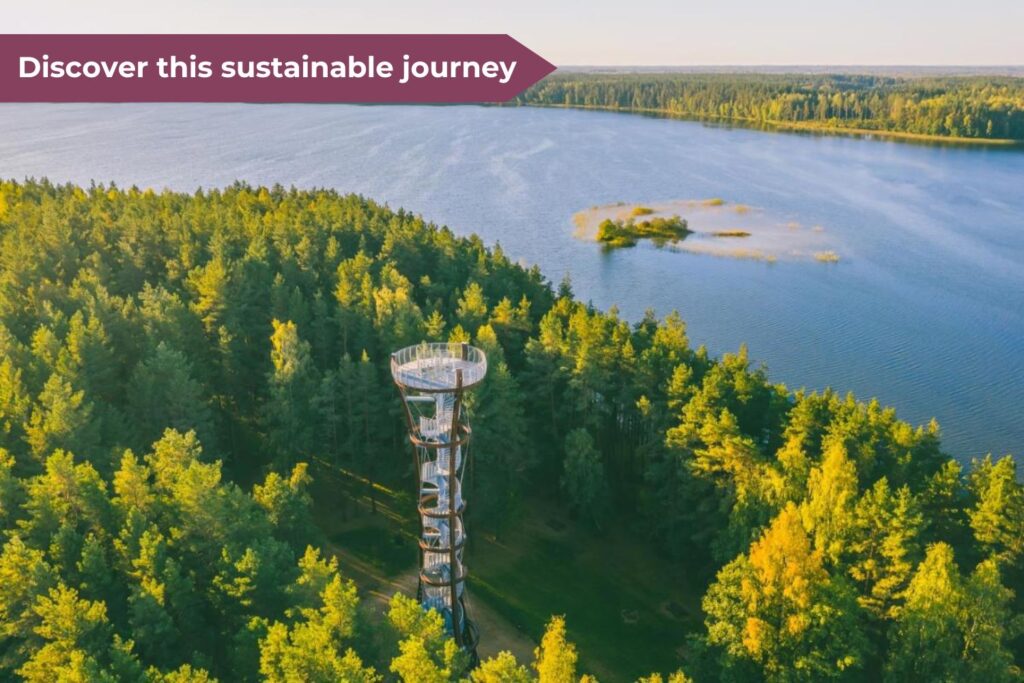
by Ben West
Ben West has written articles for many publications including The New York Times, Times, Telegraph, Independent, Guardian, FT, Vogue, GQ, New Statesman, Spectator, Mail and Express. As well as writing on travel – in the process visiting around 90 countries – he has penned articles on the arts, health, property and numerous other subjects. He has written a number of books, including the only dedicated English language guide to Cameroon for Bradt, and also a stage play, Gertrude’s Secret, which was performed at theatres around the UK for three years.
This editorial reflects experiences you can enjoy on Sustainable Journeys 11-night the Baltics by Electric Car trip. Find out more here.
It has to be said that the Baltic states aren’t the place to head if you’re looking for cuisine largely sourced from imported ingredients, high-end shopping with products manufactured in distant sweatshops, and stays in hotels owned by huge chains.
However, if you’re wanting a holiday full of outdoor adventure where sustainability is very much the focus, Estonia, Latvia and Lithuania are ideal.
Being small countries, distances from key places to visit aren’t that great and public transport is efficient and cheap, usually using the most modern coaches and trains. Many roads are surprisingly empty, so if you’re driving you’re unlikely to get caught in traffic jams. Souvenirs will have almost certainly been made locally, while shops, restaurants and hotels are usually locally run, and what you’ll spend – which will be a challenge in itself as everything is such good value – is very likely to benefit local communities rather than big companies and their shareholders on the other side of the world.
With these countries being amongst the least populated in Europe you’ll enjoy vast green spaces, little pollution and plenty of fresh air. Indeed, the Baltics represent some of the greenest countries in the world, with around 40 per cent of their land area covered in forest.
With 15 national parks between them, the Baltic states are ideal for pursuits like hiking, biking, canoeing and boating on the many lakes, and much more.
Keen to experience the wonders of the Baltics for yourself? On this 11-night EV trip, you’ll explore the must-see attractions of Lithuania, Latvia, and Estonia. You’ll stay in responsible accommodations and discover the unique Setooma heritage, enjoy a farmers market tour in Riga, and experience the fantastic Anykščiai Treetop path.


It’s possible to stay in log cabins in these parks. In an effort to reduce my carbon footprint, I tried staying in one at Tudusoo Nature Reserve in the northeast of Estonia. I’ve always erred towards comfort – ideally an air-conditioned, central heated hotel room with all mod cons – and therefore I was a bit nervous about staying in this cabin, which was very rustic and basic.
What was lost in comfort was easily made up in having such a special experience closely and completely surrounded by nature. The fresh air was glorious, and the many pine and spruce trees in the vicinity ensured an irresistible, heady scent. It was a real novelty for a townie like me to gather wood to create a mesmerising campfire and cook without an electric hob.
An added bonus was the exotic sounds of the wildlife, especially the birds: there are nearly 400 species of bird in the Baltic states, and a great place for keen birders to head is Ķemeri National Park, where you can see thousands of migrating birds.
If staying in a really basic log cabin sounds too radical, it’s possible to compromise by staying in one with creature comforts, such as the Scandinavian-style cabins at Palūšės kopa in Aukstaitija National Park, Latvia, which boast kitchenettes and balconies or patios. You’re enveloped by nature, but not at the expense of a comfy bed, on-tap heating and lighting, and a kettle always at arm’s length.
I always try a bit of kayaking or canoeing when I can. On still waters it is so calming, and rapids get the adrenaline pumping. You can appreciate, being surrounded by water, the beautiful landscapes from a different perspective than on land. The vast lake areas in the Baltics – there are more than 7000 lakes in total – are ideal for kayaking, and Aukstaitija National Park in Lithuania, Gauja National Park in Latvia, and Lahemaa National Park in Estonia all have a number of exhilarating guided and self-guided options.
The Baltics have countless peat bogs, swamps, and marshes. Kemeri in Latvia is one of the national parks with extensive bog land which you can walk on – as long as you have the right equipment. I sampled one of the two bog trails at Kemeri, which was great fun.
The park possesses 382 km2 of ancient raised bog, and a trek here involves strapping on bog shoes (which are not dissimilar to snowshoes) as the ground here is so waterlogged you’d quickly sink into the bogland without them.


It’s a strange sensation, not dissimilar to walking on a giant sponge, and there were lots of laughs as my party flapped our arms like penguins and wavered from side to side in order to maintain balance. Historically, peoples of the Balkans would wear bog shoes to get about, visit neighbours, farm, pick berries and the like. On such a walk, you may have an opportunity to pick some berries as you admire the rare and stunning landscapes of pools, raised bog beds, pines, mosses and wildflowers.
As you’d expect, the three Baltic States are made for conventional hiking and walking, and there are many trails crisscrossing the national parks. Indeed, there’s a long-distance hiking route, The Forest Trail, leading through forested lands, regional nature, and national parks of the three countries. The route starts from the Polish-Lithuanian border near the town of Lazdijai, goes through Latvia, and finishes in Tallinn, Estonia. But you’d need to be pretty committed to tackle it, as it extends 2,141 kilometres and takes more than 100 days to complete.


If you have a particular interest in wildlife, tours are available in the region to see iconic mammals such as the lynx, the brown bear and the wolf. Other animals and birds you might see include elks, deer, woodpeckers, eagles and hawks.
The Baltic States are also ideal for cycling, especially if, like me, you don’t enjoy cycling up steep hills. Much of the terrain is relatively flat, and for those who want to limit their exertion when hills do appear, eBikes are increasingly available to hire in the region.
If you have a head for heights, you can also try paragliding in all three countries, and costs are likely to be substantially lower than in many other European ones.
During winter, opportunities to explore the natural landscapes change. At these times you can try riding on a kicksled, a chair mounted on two metal runners, propelled by kicking. Ideal for traversing icy surfaces and packed-down snow, you can reach speeds of 9mph or more, and it represents a fantastic workout.
Another winter option is to hike with snowshoes. Their large footprint spreads your weight and allows you to travel largely on top of rather than through the snow.
Those with an interest in astronomy will be glad to know that the extremely low population densities of the Baltic nations mean that star gazing is particularly good in the region because of the low light pollution. There are just 29 people per square kilometre/76 per square mile in Latvia, 43 per square kilometre/112 per square mile in Lithuania, and 31 per square kilometre/81 per square mile in Estonia.
I recently flew in an Airbus 320 seating nearly 200 passengers that was less than a fifth full and then stayed in a hotel room with a jacuzzi I didn’t want and couldn’t turn off that was running 24/7. There were ranges of miniature shampoo and shower gel bottles in the bathroom and a stack of plastic mineral water bottles by the minibar. It really brought home to me the urgency to choose sustainable holidays as much as possible from now on, and my Baltic experiences fulfilled all of that.
It was a great feeling to eschew wasteful, eco-unfriendly, unnecessary comforts and outdated travel habits, instead incorporating enough sustainable actions that made me really feel I was doing something meaningful to help the planet.
And of course, there was also the great satisfaction of the bragging rights of taking a holiday that was as guilt-free as possible, not having to worry about someone taking me to task for travelling abroad in these climate-challenged times.
Feeling inspired? Experience the magic for yourself by booking Sustainable Journeys 11-night the Baltics by Electric Car trip.









